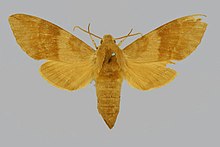Clarina Kochyi
| Clarina Kochyi | ||||||||||||
|---|---|---|---|---|---|---|---|---|---|---|---|---|

Clarina kotschyi , male |
||||||||||||
| Systematics | ||||||||||||
|
||||||||||||
| Scientific name | ||||||||||||
| Clarina Kochyi | ||||||||||||
| ( Kollar , 1849) |
Clarina kotschyi is a butterfly ( moth ) from the family of moth (Sphingidae). According to Kitching & Cadiou (2000) the taxon is the sister species of Clarina syriaca , while the latter is only considered as a subspecies of Clarina kotschyi by Pittaway.
features
The moths have a wingspan of 60 to 80 millimeters and are therefore significantly larger than Clarina syriaca . The wing pattern of the two similar species differs in that C. syriaca has significantly fewer and paler oblique bands on the forewings and the outer edge is less toothed. The wing color of C. kotschyi is very variable and ranges from reddish brown to pale gray with brown pollination.
The caterpillars are 55 to 70 millimeters long. They are initially three to four millimeters long and colored pale yellow. They have a cylindrical body cross-section and a black, straight, almost straight upwards, 1.25 millimeter long anal horn . After the first ingestion of food, the animals turn yellowish-green. In the second stage the anal horn is colored pink and the body is already showing the final color: on the side of the back there is a yellow longitudinal line from the head to the anal horn, on the body there are numerous yellow dots and the back of each segment has an inverted V. Im In the last stage of the caterpillar, the third thorax segment and the first abdomen segment are enlarged so that the segments in front of them and the head can be withdrawn in the event of a threat. In addition, the green base color below the dorsolateral longitudinal line is slightly gray-blue and a narrow ventrolateral line appears above the thoracic bones .
The oval eggs measure 1.5 by 1.25 millimeters. They are pale yellowish-green and often include a clearly recognizable air bubble, as can also be observed in the eggs of the linden hawk ( Mimas tiliae ).
The doll is 35 to 48 millimeters long. It is similar to that of the oleander swarm ( Daphnis nerii ). The wing sheaths are transparent brown, with the wing veins highlighted by lines of dark brown spots. As with the oleander hawker, the compound eyes are partially edged with a crescent-shaped pattern. The spiracles are outlined in dark.
Occurrence and habitat
The species is distributed from the Iranian highlands over Mesopotamia to eastern or central Turkey. Hybrid populations with C. syriaca occur in central Turkey . In central Iran, where the species occurs locally up to heights of 2000 meters, it lives in mountain valleys with bushes, vineyards and isolated trees. It can be very common in some wine-growing regions.
Way of life
The butterfly resting during the day hidden in the dense foliage of the larval food plants or on stones on the ground. At dusk, all animals begin to fly, including those that only hatched in the afternoon. At first they look for sources of nectar for a short time.
Flight and caterpillar times
The moths fly in three overlapping generations per year from the beginning of May to the end of August. The caterpillars can be seen from early May to September. Often, several stages occur at the same time.
Food of the caterpillars
The caterpillars feed on grapevine ( Vitis vinifera ), virgin vines ( Parthenocissus ) and Ampelopsis .
development
The females lay their eggs individually on the top and bottom of the leaves of the host plants. They prefer plants that grow on the slopes of ravines, the edges of vineyards, or in gardens. During its entire development, the caterpillar always sits elongated on the underside of the leaf along the midrib and rarely shows more than the head and the first two thorax segments while feeding. The caterpillars live extremely hidden and withdraw at the slightest alarm. Your movements are slow, deliberate, or jerky. The caterpillars are very voracious and eat continuously for the duration of their development. Shortly before pupation, the animals turn reddish-brown and wet their bodies with salivary secretions, in order to then climb down from the food plant under cover of darkness. Pupation takes place in a loosely spun cocoon made of light brown silk between parts of plants and stones at the base of a rock or a tuft of grass. The pupa hibernates. Parasitoids of the species are not known.
